Physikerin der Woche 2024
Starting from January 2018, the German Physical Society's working group on equal opportunities (AKC) has been regularly featuring women in physics who are based in Germany or German women who are working in the field of physics abroad.
If you are a woman working in the field of physics in Germany or a German woman working in physics abroad and would like to showcase your work through the "Physikerin der Woche" initiative, then don't hesitate to get in touch with Dr. Ulrike Boehm at . This opportunity is open to women in physics at all career stages, whether they are from academia or industry. Moreover, you are also welcome to recommend suitable candidates for the initiative.
You can find an article and posters about our initiative in the April 2018 issue and 2021 / 2022 / 2023 issues of the Physik-Journal. You are welcome to print the posters and promote our initiative at your research institution. To view previous participants from past years, please refer to the following resources: 2018, 2019, 2020, 2021, 2022 and 2023.
Further interesting information on the topic of career preparation for physicists can also be found on the following DPG pages: Berufsvorbereitendes Programm der DPG and DPG-Berufsvorbereitung online der jDPG
December
Dr. Silke Stähler-Schöpf (Garching) - Kalenderwoche 52
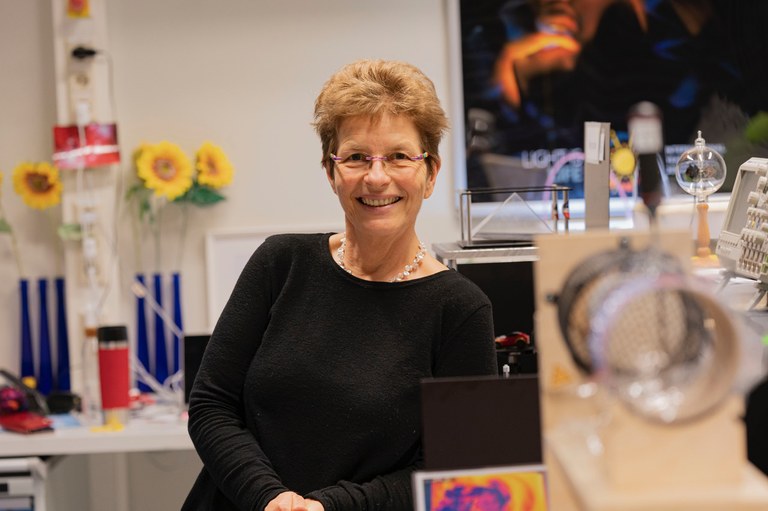
Silke and her team give school classes a first insight into laser, light, and quantum phenomena. The focus is on experiments that the school students themselves can perform. Besides that, she contributes to a lot of activities for public outreach like stands at various fairs, open house day, competitions (GYPT), GirlsDay, Maustag, quantum Tuesday, quantum Friday……and co-founded MUC-Labs, the organization of student labs near Munich. Another specialty is the podcast "Alice im Quantenland" (in every podcast app) for children from 6 years old, where Alice experiences bizarre adventures with Schrödinger, the cat.
Silke obtained her PhD in solid-state physics at TU München. After a family break, she gave guided tours at the Deutsches Museum for school classes before she started to set up the "PhotonLab". She will be awarded the DPG Georg Kerschensteiner Preis in 2025.
Foto-Rechte: Dr. Silke Stähler-Schöpf
Prof. Dr.-Ing. habil. Christine Ruffert (Cottbus, Dresden) - Kalenderwoche 51
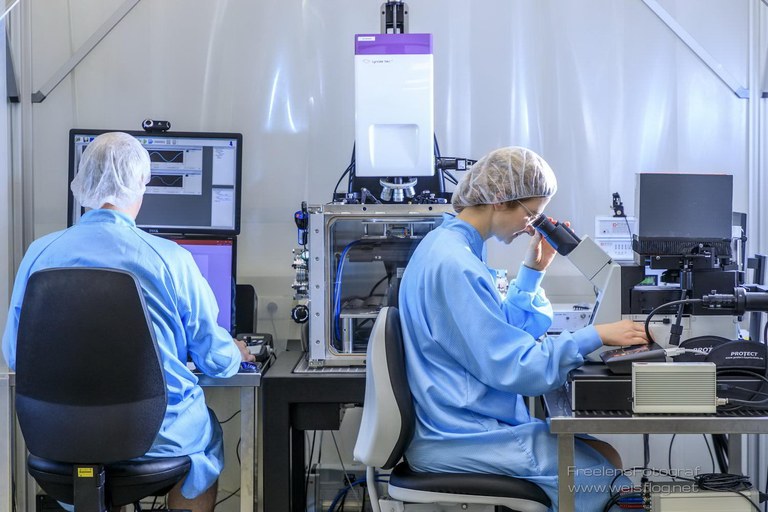
Christine is a physicist and engineer, calling herself a “hybrid” scientist. She works as a researcher and lecturer at the Brandenburg University of Technology Cottbus-Senftenberg (BTU) and the Fraunhofer Institute for Photonic Microsystems IPMS in Dresden. She is also a member of the Technische Universität Braunschweig, where she accomplished her habilitation in 2017, and is still teaching microfluidics in cooperation with the Institute for Microsystems in Braunschweig.
Christine feels at home in the micro and nanoworld: after her diploma in physics at the Leibniz University of Hanover in 2002, comprising the set-up of an optical dipole trap for cold Rb87-atoms, she started working in microsystems technology – a highly interdisciplinary field. In 2012, she spent a research year at the École Polytechnique de Fédérale de Lausanne EPFL to learn the basics of microfluidics. Today, she covers three areas of expertise: microactuators, microsensors, and microfluidics.
In Lusatia (Lausitz), Christine has the unique chance and possibility to be an active part of the structural change as the manager of the project “Innovation campus electronics and microsensors (iCampµs)” and by bringing in her ideas, such as the iCampµs-Cottbus Conference iCCC2024, see www.iccc2024.de. One of the main tasks as iCampµs manager is to transfer the research developments to industrial applications. Since September 2024, she has also been an associate professor at the BTU-CS for applied physics and microsystems technology, attracting the next generation to her favorite research fields.
Foto-Rechte: Rainer Weisflog
Dr. Katharina Behr (Hamburg) - Kalenderwoche 50
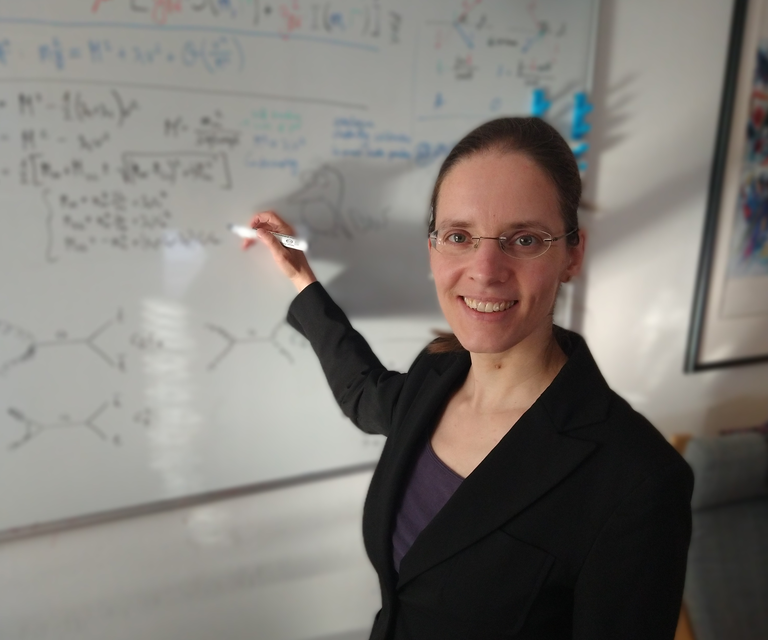
Katharina searches for new phenomena in collision events with a pair of top quarks in the data collected with the ATLAS experiment at CERN, targeting the interference patterns that could be indicative of additional Higgs bosons and new particles involved in the interaction between dark matter and ordinary matter. She also searches for Higgs boson pair production, a rare process predicted by the Standard Model that is crucial to our understanding of the vacuum structure and could be enhanced in the presence of new particles and interactions. Furthermore, Katharina conducts precision measurements of quantum effects, such as entanglement, in fundamental quarks at the high energy scales of the Large Hadron Collider and is an expert on the reconstruction of particle trajectories in the ATLAS silicon detectors at high particle densities.
Besides her research, Katharina is a mentor for early-career researchers from a variety of STEM fields, sharing her experience in navigating academia and enjoying the cross-disciplinary exchange in these mentor-mentee discussions.
Katharina obtained her PhD in Particle Physics at the University of Oxford on a Rhodes scholarship after completing her undergraduate degree in physics at LMU Munich on a Maximilianeum scholarship. She was awarded the DPG Hertha Sponer Preis in 2024.
Foto-Rechte: Dr. Katharina Behr
M.Sc. Lara Markus (Hamburg) - Kalenderwoche 49
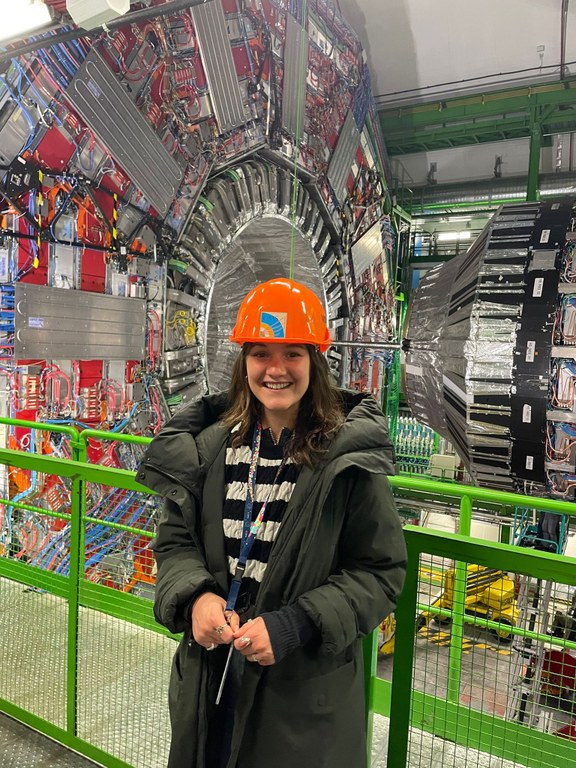
The Higgs self-coupling is a crucial parameter of the SM, as it is directly related to the shape of the Higgs potential. Measuring the cross-section of pair-produced Higgs bosons provides a direct handle on the Higgs self-coupling and is, therefore, an important area of research for confirming or rejecting the predictions of the SM.
Currently, Lara is setting up an analysis to search for such Higgs boson pairs with subsequent decays into a b-quark anti-quark pair and two W bosons using data from the CMS experiment at CERN.
Foto-Rechte: M.Sc. Lara Markus
November
Dr. Stefanie Tafelmeier (Garching) - Kalenderwoche 48
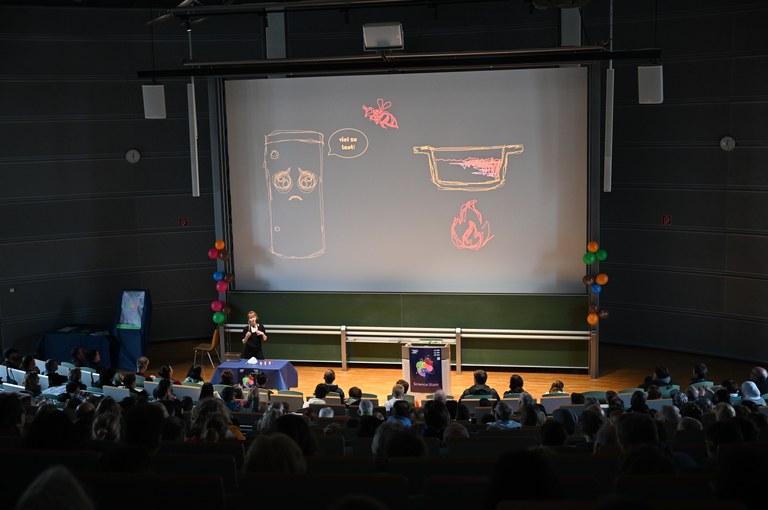
Currently, she works as a research assistant in the field of sustainable energy storage technologies at the Bavarian Center for Applied Energy Research (ZAE Bayern), focusing on thermal energy storage.
The diversified work spans from nanoscopic research on the crystallization of phase change material with molecular dynamic MD simulations to the macroscopical analysis of the crystallization velocity via microscopy to building experimental setups for storage tests.
Furthermore, it is one of her goals to make research more approachable and especially to show young girls that there is a lot of space for female scientists in the research society. For this, she attended events like Soapbox Science or Science Slam (see photo).
Foto-Rechte: Carolin Lerch / TUM
Prof. Dr. Estela Suarez (Bonn) - Kalenderwoche 47
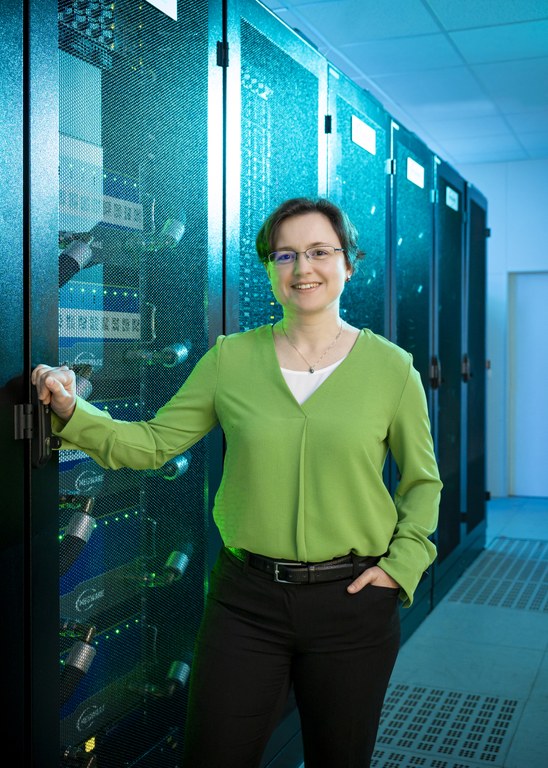
Foto-Rechte: Forschungszentrum Juelich GmbH / Sasha Kreklau
Dr. Irene Morales (Hannover) - Kalenderwoche 46
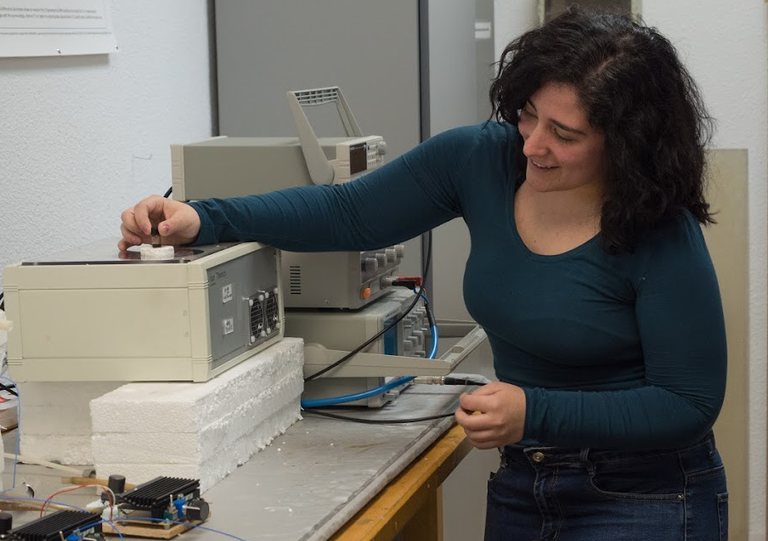
Foto-Rechte: Pilar Marín Palacios
Prof. Dr. Elisabetta Gallo (Hamburg) - Kalenderwoche 45
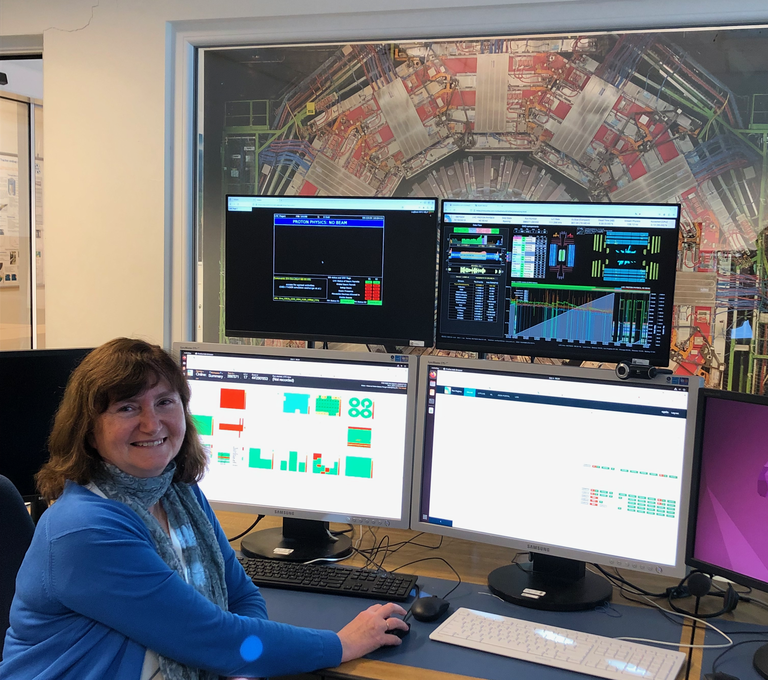
Elisabetta is a leading scientist at the DESY laboratory and a full professor at the University of Hamburg in experimental particle physics. She is also a principal investigator of the Cluster of Excellence Quantum Universe.
Her research is focused on Higgs boson physics and tests of the electroweak force at the Large Hadron Collider with the CMS experiment. Her group of postdocs and young students applies the most modern methods, like machine learning, to study the Higgs mechanism in great detail, which is the mechanism that gives mass to the elementary particles.
She is presently also chairperson of the CMS Collaboration Board. In this role, she is steering the process of taking decisions in such a large international Collaboration with more than 250 institutes worldwide. This interesting job allows her to interact with many colleagues from different nationalities and cultures.
Foto-Rechte: Dr. Andrea Cardini
October
M.Sc. Anna Oberbauer (Munich) - Kalenderwoche 44
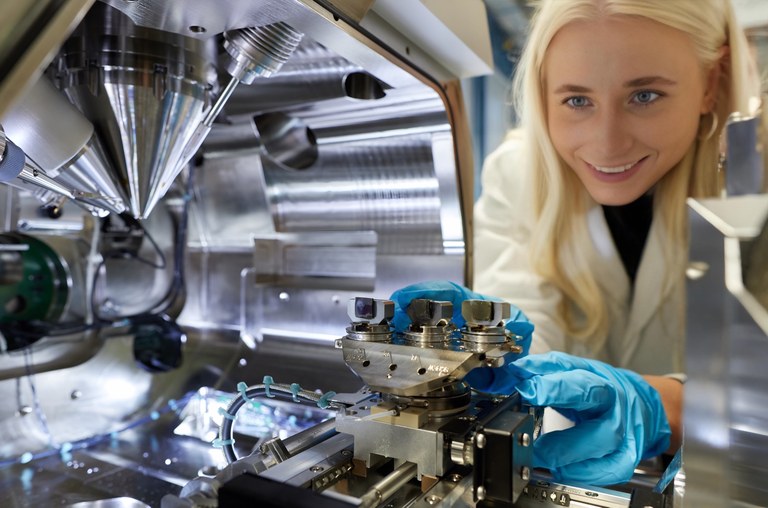
Foto-Rechte: Bernhard Ludewig
Dr. Isabell Melzer-Pellmann (Hamburg) - Kalenderwoche 43
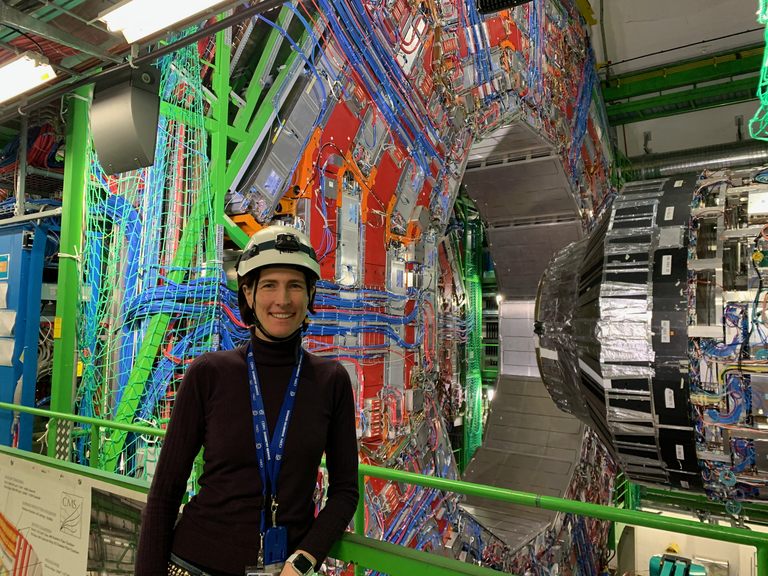
Isabell is an experimental particle physicist at the Deutsches Elektronen-Synchrotron DESY. She leads the DESY-CMS group, which is one of the largest groups working at the Compact Muon Solenoid (CMS) experiment at the Large Hadron Collider (LHC) at CERN. Her research is specifically focused on the search for new physics beyond the Standard Model of particle physics that can explain the existence of dark matter. From 2009-2014, she led a Helmholtz Young Investigator Group at DESY and Hamburg University to search for supersymmetry at CMS. Before that, she worked on the understanding of the proton structure with the ZEUS experiment at HERA - the world’s only electron-proton collider that was located at DESY - and measured Kaon rare decays at the NA48 experiment at CERN. She incorporates machine learning on all levels of data analysis, starting from generating collider data more efficiently - supported by a HelmholtzAI grant - up to classification tasks to distinguish new physics from known Standard Model processes.
She is highly interested in bringing girls into the field and regularly organizes events with experiments and lab visits for school girls. In addition, she is active in outreach events like “Wissen vom Fass” to bring science to the public.
Foto-Rechte: Dr. Isabell Melzer-Pellmann
Janine Graser (Düsseldorf) - Kalenderwoche 42
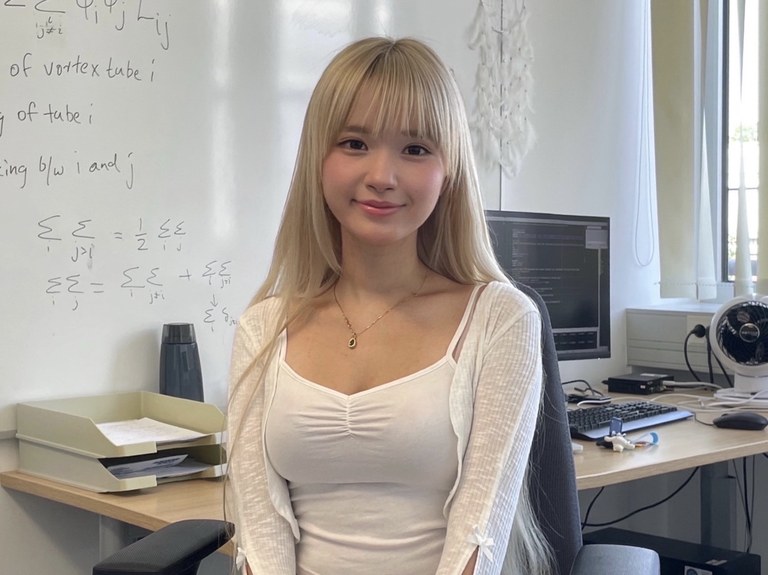
Alongside her studies, she works as a student assistant in the TWIST Group, led by Prof. Karin Everschor-Sitte at the University of Duisburg-Essen, where she engages in research activities in the Collaborative Research Center SFB/TRR270 HoMMage Project B12. The project focuses on optimizing magnets by using machine learning to identify material inhomogeneities.
Additionally, Janine is responsible for science communication within the AKPIK (Working Group on Physics, Modern Information Technology, and Artificial Intelligence) of the DPG, where she is currently creating a series of Instagram posts that highlight the role of AI in physics.
Foto-Rechte: Dr. Thomas Schlake
Prof. Dr. Freya Blekman (Hamburg) - Kalenderwoche 41
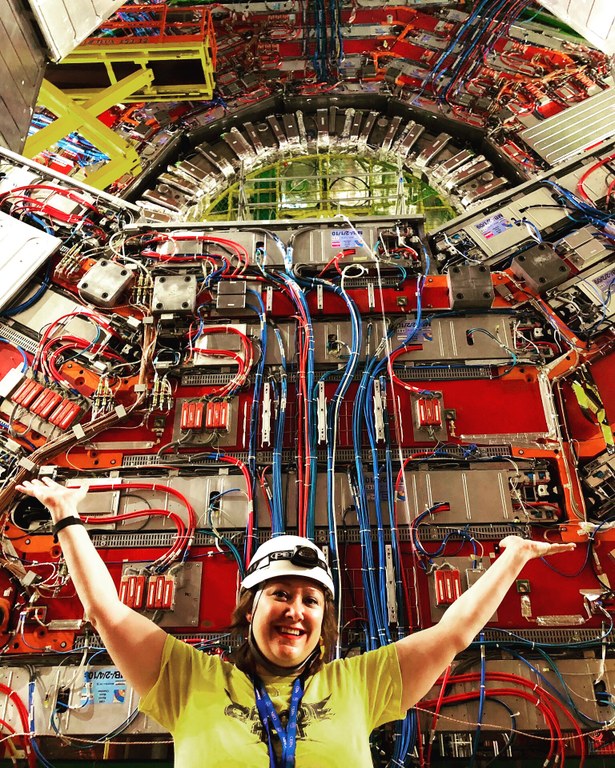
Foto-Rechte: Z. Szillasi
September
Dr. Leilani Torres (Hannover) - Kalenderwoche 40

Foto-Rechte: Dr. Leilani Torres
B.Sc. Amelie Coumans (Stockholm, Sweden) - Kalenderwoche 39

In addition to her studies, Amelie also holds the position of chairperson at the Young DPG (jDPG). In this role, she is responsible for coordinating the work of the national board. She represents the jDPG within the DPG towards other committees and structures, as well as external partner organizations. Amelie advocates for the desires and aspirations of the young members within these contexts.
Foto-Rechte: B.Sc. Amelie Coumans
Dr. Stephanie Willms (Hannover) - Kalenderwoche 38
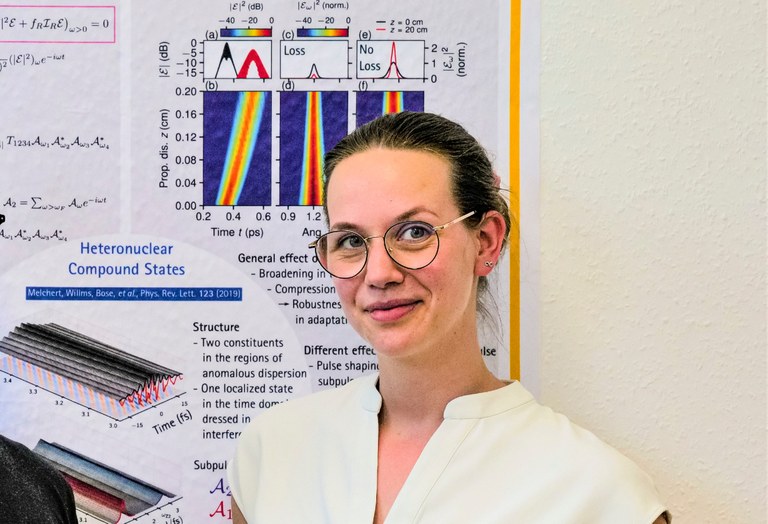
Stephanie studied physics at the Leibniz University Hannover and recently finished her Ph.D. in theoretical optics and computational photonics. During her time as a researcher at the Institute of Quantum Optics, she worked for several months at Columbia University in New York City in the area of nano-photonics. In her work, she investigated light interactions in waveguides such as optical fibers, particularly bound states of light. Such photonic molecules show to have intriguing characteristics and many similarities to actual atomic molecules. Her research focuses on describing the fundamental properties of these novel objects, investigating how they interact with other light pulses, and finding realistic scenarios for their usage in diverse applications in science.
Foto-Rechte: Sonja Smalian/PhoenixD
M.Sc. Clara Klink (Geneva, Switzerland) - Kalenderwoche 37
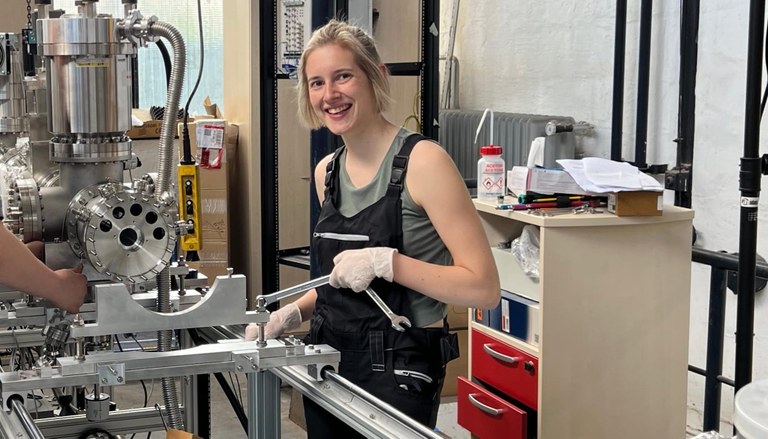
Foto-Rechte: M.Sc. Clara Klink
M.Sc. Karin Hansen (Kiel) - Kalenderwoche 36
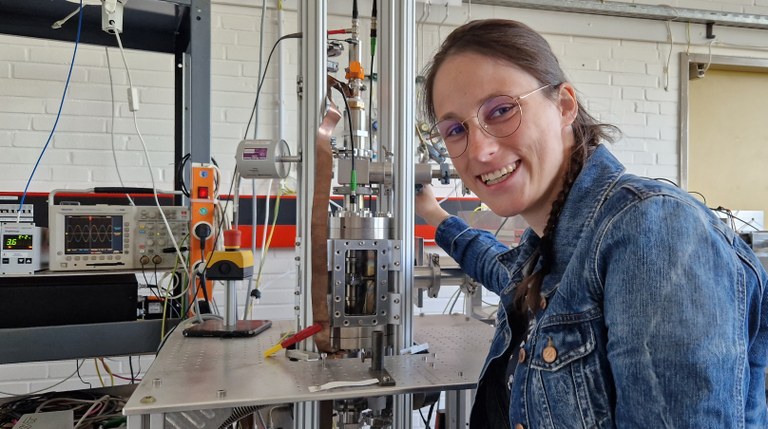
Karin recently completed her Master's at Kiel University's Institute of Experimental and Applied Physics. During her studies, she conducted her Master's thesis under the supervision of PD Dr. Franko Greiner in the Experimental Plasma Physics group. Her research focused on investigating the interaction between highly porous, multi-scale aeromaterials, developed at Kiel University's Technical Faculty in the group of Prof. Dr. Rainer Adelung, and low-pressure, radio frequency argon plasmas. Employing techniques such as optical emission spectroscopy and electrostatic double probes, she aimed to elucidate the potential of plasma-aeromaterial composites for plasma catalysis.
Foto-Rechte: Isabel König
August
Dr. Hannah Jeckel (Pasadena, CA, USA) - Kalenderwoche 35
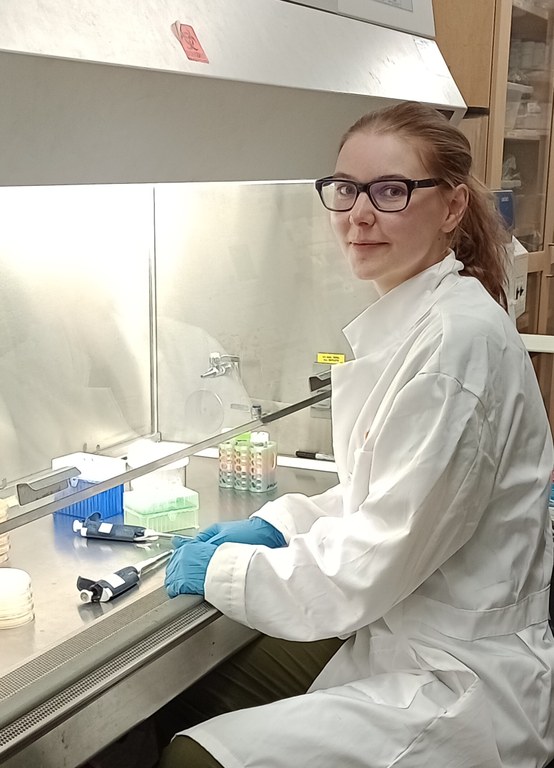
Hannah is a postdoctoral researcher at the California Institute of Technology in the USA, where she explores how root-colonizing microbes assemble into communities that form the rhizobiome, which, similar to how the human gut microbiome contributes to our well-being, can influence plant health. Her interest in biological topics sparked while she was still a master's student at the Philipps-University in Marburg, Germany, where she used a mathematical model to describe how physical forces shape the collective movement of swarming bacteria. Since then, she has been passionate about utilizing her quantitative background to explore biological systems, for example, by developing a robotic sampling system that works in synchrony with a microscope or the image analysis software BiofilmQ, which is freely available to researchers in the field. Hannah is autistic and has ADHD, conditions which she says are not uncommon among scientists but still lack support and awareness. She hopes that by being open about her challenges and experiences, she can contribute to creating an inclusive research environment and help others find confidence that they belong.
Foto-Rechte: Dr Hannah Jeckel
Prof Dr Reinhild Yvonne Peters (Manchester, UK) - Kalenderwoche 34
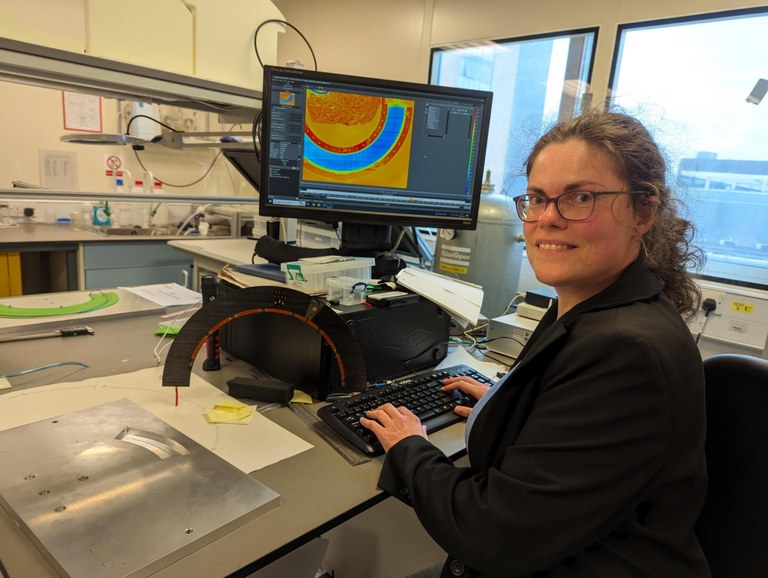
Yvonne is an experimental particle physicist at The University of Manchester. Already during her PhD at the University of Wuppertal, Yvonne dedicated her research to the heaviest elementary particle, the top quark. Due to their high mass and fast decay time, top quarks are particularly intriguing in many models of new physics beyond the standard model of particle physics.
She performed many world-leading and novel measurements of top quark properties and searches for new physics in the top sector, first at the D0 experiment at Fermilab, and since 2012 at the ATLAS experiment at the LHC at CERN, aiming at a deeper understanding of the top quark, its connection to the Higgs boson and its relation to new physics models that could explain the matter-antimatter asymmetry in today’s universe.
In 2012, Yvonne was awarded a Helmholtz Young Investigator Group at DESY, and since 2013, is leading a research team at The University of Manchester, first funded by an ERC starter grant, “COLORTTH,” and currently by an ERC consolidator grant “TheHiggsAndThe7Tops”. In 2025, Yvonne will direct her project towards searching for new physics effects in rare events of pairs of top quarks and Higgs bosons with her recently awarded ERC advanced grant “HeavierByTheDozen.”
Foto-Rechte: Dr Matteo D'Uffizi
Dr Helen Bieker (Norderstedt) - Kalenderwoche 33
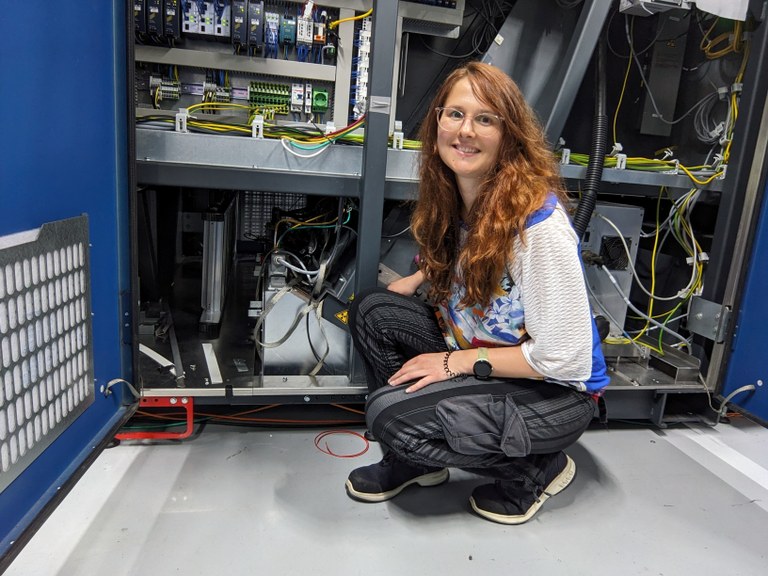
Helen has worked as a Scientist at the Research and Development facility of Smiths Detection in Norderstedt, north of Hamburg, since 2021. She studied Physics at the University of Bremen and finished her PhD at the Universität Hamburg. Her doctoral research, conducted within a group at the Center for Free-Electron Laser Science (CFEL) at DESY, focused on experimental and theoretical studies of water clusters. As part of her role at Smiths Detection, she applies her knowledge of X-ray techniques, Python programming, and image processing to develop an airport baggage inspection machine whose detection capability is based on X-ray diffraction, a very innovative concept.
Helen is responsible for the experimental validation and improvement of detection performance, which involves traveling to various locations to validate the functioning of the machines. She plays a crucial role in coordinating efforts between different teams, ensuring seamless collaboration. This requires a deep understanding of the machine's functionality, the underlying physics, and the image reconstruction algorithms.
Besides her technical role, Helen is a core team member of Smiths Detection's women@work initiative, where she shares her work experience with the global network within Smiths Detection and participates and holds workshops to ensure everyone feels safe, heard, and included.
Foto-Rechte: Bettina Meurer
Dr. Bettina Lommel (Darmstadt) - Kalenderwoche 32

Bettina is an experimental solid-state physicist with a background in single crystal growth and materials development. At GSI Helmholtzzentrum für Schwerionenforschung and FAIR (Facility for Antiproton and Ion Research) in Darmstadt, she heads the Target Laboratory, a thin-film laboratory for basic research with heavy ions. In the lab, high-purity thin films, some of which are fabricated from highly enriched and rare isotopes, are produced over a wide thickness range for application as stripper films, backing, time-of-flight films, or targets at the heavy-ion accelerator or in experiments for astrophysics, biophysics, atomic physics, material research, nuclear physics or plasma physics.
Bettina has been active in Mentoring Hessen for more than 20 years, advising many aspiring female physicists and accompanying them part of the way. Her role as elected spokesperson of the Scientific-Technical Council of GSI and as Chair of the Assembly of Scientific-Technical Councils of the Helmholtz Association gives her a deep insight into the scientific landscape and science organization in Germany.
Foto-Rechte: G. Otto, GSI
July
Dr. Elke Beyreuther (Dresden) - Kalenderwoche 31
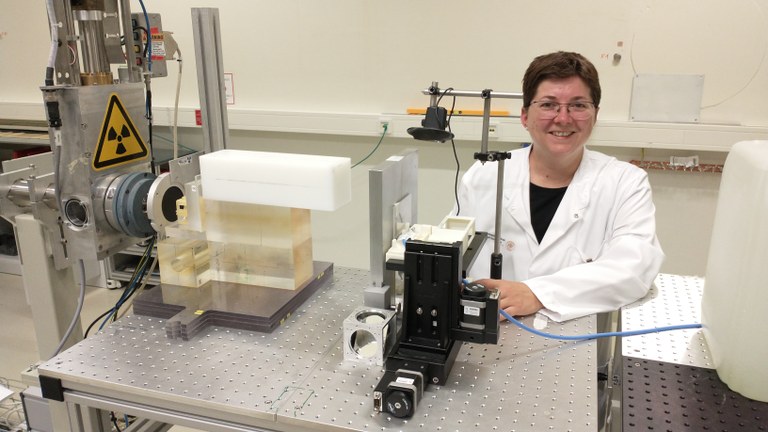
Elke is a scientist at the Institute of Radiation Physics, Helmholtz-Zentrum Dresden-Rossendorf (HZDR), and at the Oncoray - National Center for Radiation Research in Oncology in Dresden. In close collaboration with her colleagues at HZDR and Oncoray, her "Ultra-high dose-rate radiobiology" group focuses on the radiobiological characterization of new radiation qualities and its consequences for clinical application.
After she studied "Applied Natural Sciences" at the TU Bergakademie Freiberg, she performed her PhD at HZDR, dealing with the radiobiology of soft X-rays and laser-driven electron beams. During her postdoc, she proceeded with this research, setting up and performing preclinical experiments at various clinical and research proton and electron accelerators; finally, the topic of her habilitation. Making use of the different accelerators, Elke and her team develop setups, dosimetry and assays, and investigate the influence of physical beam parameters, like dose rate and pulse time structure, on the radiobiological response to ultra-high dose rate irradiation by cell and small animal experiments.
Currently, Elke is active in the "Flash focus group" of the European Society for Radiotherapy and Oncology (ESTRO) and in the European Particle Therapy Network (EPTN) – Subgroup Experimental Radiobiology for Particle Therapy.
Foto-Rechte: Dr. Elke Beyreuther
Dr. Anulekha De (Kaiserslautern) - Kalenderwoche 30
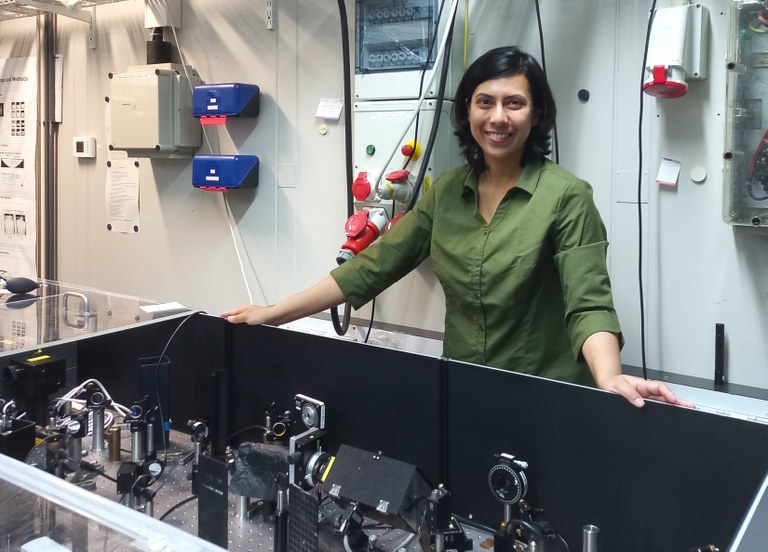
Anulekha is a physicist from India. She is a postdoctoral researcher in the Department of Physics at the Rhineland-Palatinate Technical University (RPTU) in Kaiserslautern, Germany. Anulekha has a background in physics and received her Master’s degree from the University of Burdwan, India (First Rank in University, Gold Medalist) and her Ph.D. from the S. N. Bose National Center for Basic Sciences, India. She then came to Germany for postdoctoral research in 2021. Her research focuses on experimental condensed matter physics to study ultrafast magnetization dynamics in magnetic thin films and nanostructures, as one of the major challenges of modern information technology is to develop new concepts to increase the data storage and processing speed beyond today’s GHz limit. In her research, she investigates the magnetization dynamics of magnetic materials after strong excitation by ultrafast optical pulses and aims to understand the microscopic mechanism of laser-induced magnetization dynamics on femto-, pico-, and nanosecond timescales, which is still a topic of intense debate. For the investigations, she uses all-optical pump-probe spectroscopy based on the time-resolved magneto-optical Kerr effect (TR-MOKE). In addition, she uses other experimental techniques such as Brillouin light scattering (BLS) and THz pump-probe spectroscopy. She also performs numerical simulations and frequently collaborates with other theorists to gain a deeper understanding of the experimental ultrafast magnetization dynamics.
Foto-Rechte: Dr. Rahul Bandyopadhyay
Prof. Dr. Janine Splettstoesser (Gothenburg, Sweden) - Kalenderwoche 29
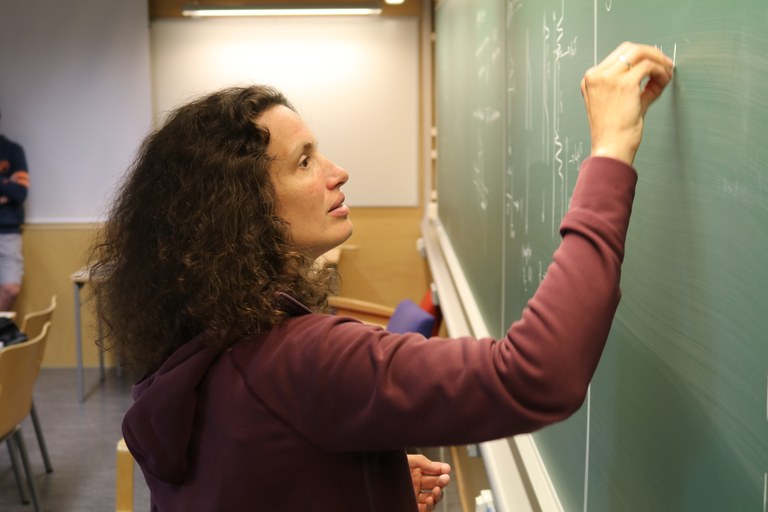
Janine is a Professor in Theoretical Physics at the Department for Microtechnology and Nanoscience at Chalmers University of Technology in Gothenburg, Sweden. Her research deals with the broad field of dynamics and thermodynamics of nanoelectronic devices. She is currently focussing on energy conversion processes, such as present in heat engines or in cooling, but in strongly nonequilibrium devices, possibly exploiting nonthermal resources—meaning that due to the small scales, devices can possibly not thermalize to definite temperatures or chemical potentials. Another unique aspect of nanoscale energy conversion is the importance of noise or precision. Here, Janine and her group are working on various constraints on achievable precision of nanoscale thermal (or nonthermal) machines.
Janine is currently also acting as director of the Nano Area of Advance at Chalmers. She recently received an ERC consolidator grant in the field of quantum and nanoscale thermodynamics and was awarded the Letterstedtska prize of the Royal Swedish Academy of Sciences.
Foto-Rechte: Lovisa Håkansson
M.Sc. Jessica Schleitzer (Kiel) - Kalenderwoche 28
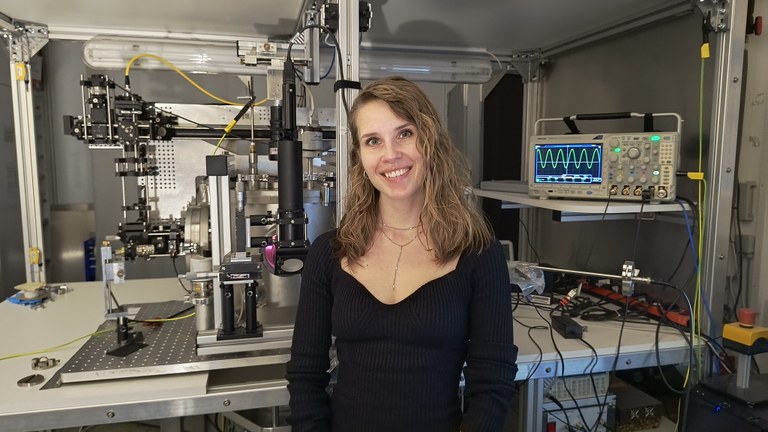
Jessica is a PhD student at the Institute of Experimental and Applied Physics at Kiel University in the “Plasma Technology” group of Prof. Dr. Holger Kersten. Her research falls into the area of fundamental research and is centered around the plasma diagnostics of radiofrequency discharges with a particular emphasis on the use of optically trapped microparticles as plasma probes. In this very specialized and, with respect to the plasma, non-invasive diagnostic method, micrometer-sized silica spheres are trapped using a highly focused laser beam and then moved into different regions of the plasma. By observing the behavior of the trapped particle in the laser, insights into various plasma properties can be derived, leading to a comprehensive understanding of the plasma under investigation.
Foto-Rechte: M.Sc. Jessica Schleitzer / CAU Kiel
M.Sc. Sabine Rockenstein (Hamburg) - Kalenderwoche 27
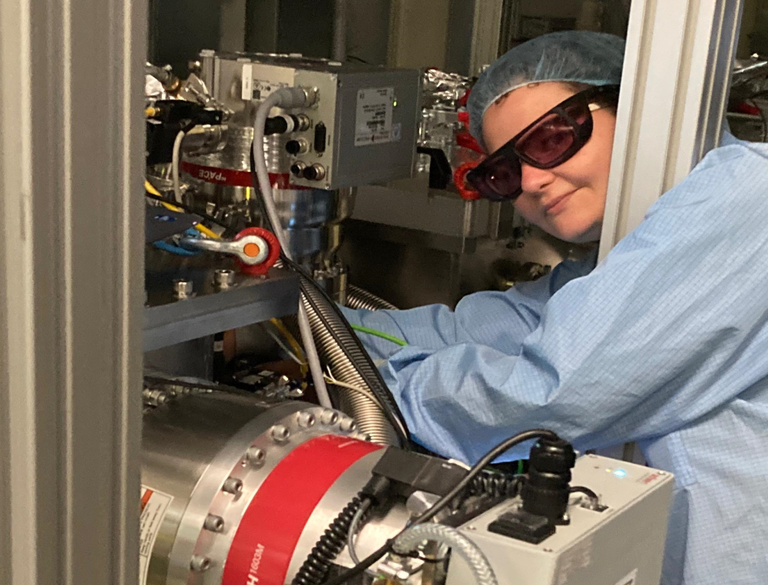
Sabine develops a novel source of ultrashort light pulses for studies of interactions between light and matter. These pulses, produced by high-order harmonic generation, cover energies in the soft x-ray spectral range and enable the observation of coherent electron dynamics with extreme time resolution. In combination with a liquid jet to create an aqueous environment, this table-top experimental setup allows to perform attosecond spectroscopy of solvated molecules.
Her motivation is to contribute to the understanding of fundamental processes in molecular systems that happen in chemical and biological contexts. Furthermore, Sabine is passionate about communicating science and is engaged within the young German Physical Society and the International Association of Physics Students.
She is pursuing a doctorate at DESY and the University of Hamburg, is a member of the Attosecond Science group at the Center for Free-Electron Laser Science, and a fellow of the International Max Planck Research School for Ultrafast Imaging and Structural Dynamics.
Foto-Rechte: M.Sc. Sabine Rockenstein
June
Dr. Maria Azhar (Duisburg-Essen) - Kalenderwoche 26
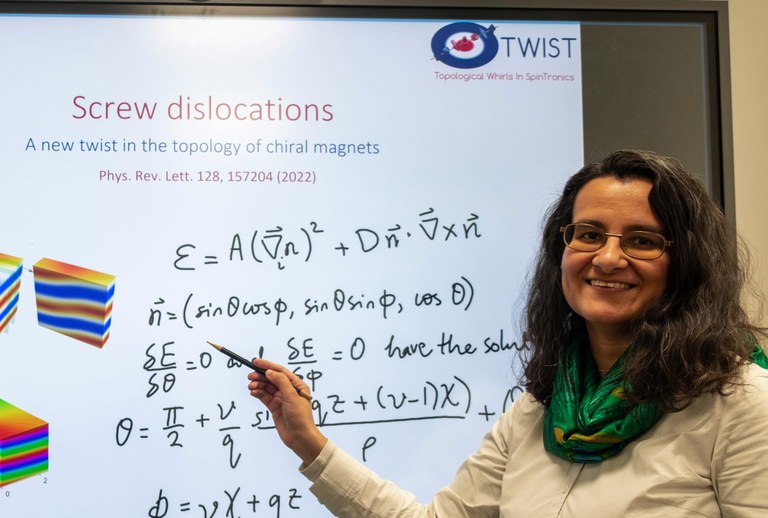
Maria is a postdoctoral researcher at the Faculty of Physics at the University of Duisburg-Essen. She has a nanoscience and physics background and a PhD from the University of Groningen in the Netherlands. Her research is centered on the theoretical study of topological magnetic textures or “knots” in the continuous magnetic field in matter. These include complex structures such as spin spirals, skyrmions, hopfions, and dislocation lines. Maria employs a combination of analytical techniques and numerical simulations to study the stability and properties of these magnetic textures. Recently she predicted a new topological defect in the magnetic texture -- a “screw dislocation.”
Such magnetic textures are significant because they provide deeper insights into fundamental physics questions related to topology, symmetry, and conservation laws. Moreover, they have practical applications with the potential to revolutionize the current paradigm of 2-bit magnetic data storage devices, potentially leading to major advancements in current computation technology.
Beyond her research, Maria enjoys teaching at the university and is an active member of the academic community. She frequently collaborates with other researchers, both experimentalists and theoreticians and engages in the organization of scientific conferences.
Foto-Rechte: Dr. Maria Azhar
Juniorprofessorin Dr. Christina Jörg (Kaiserslautern) - Kalenderwoche 25

Christina is a junior professor at RPTU Kaiserslautern-Landau working in optics and photonics. She studies how light propagation can be manipulated with structures on the scale of nm to µm. Her research focuses on topological photonics, exploring the behavior of light in systems of coupled waveguides or photonic crystals where the properties of light waves are topologically protected, meaning they are robust against defects or imperfections. In her current research, she investigates the interplay between topological robustness and nonlinear optical effects with the help of 3D micro-printed structures.
Foto-Rechte: Dr. Christina Jörg
Dr. Lisa-Marie Kern (Berlin) - Kalenderwoche 24
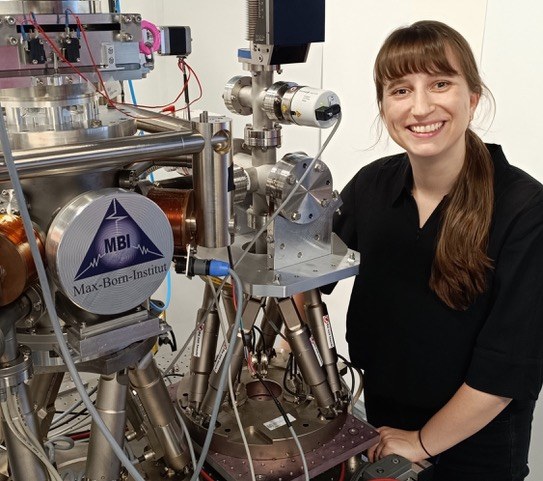
Lisa is a postdoctoral researcher at the Max Born Institute (MBI) for Nonlinear Optics and Short Pulse Spectroscopy in Berlin. She combines nanofabrication, laser technology, and x-ray imaging to investigate complex spin textures in magnetic thin films.
She studied Physics in Germany and France: she went to Nancy, Luxembourg, and Saarbrücken for her bachelor's degree, before moving to Berlin and Paris for her master's studies.
During her PhD studies at MBI, Lisa worked on the manipulation of chiral magnetic quasiparticles, so-called skyrmions. She developed an approach that allows controlling the positions of individual skyrmions with a few nanometers' precision. For example, the control achieved has led to the guided motion of nanometer-scale skyrmions over micrometer distances, which may become relevant for spintronic applications. In addition, Lisa's experiments to image such spin textures in real-time provided new fundamental insights into their dynamics upon ultrafast stimuli.
Lisa was recently awarded the Carl Ramsauer Prize 2023 of the Berlin Physical Society and the Dissertation Prize 2024 of the Condensed Matter Section (SKM) of the German Physical Society (DPG).
Foto-Rechte: Dr. Lisa-Marie Kern
Dr. Mariana Rossi (Hamburg) - Kalenderwoche 23
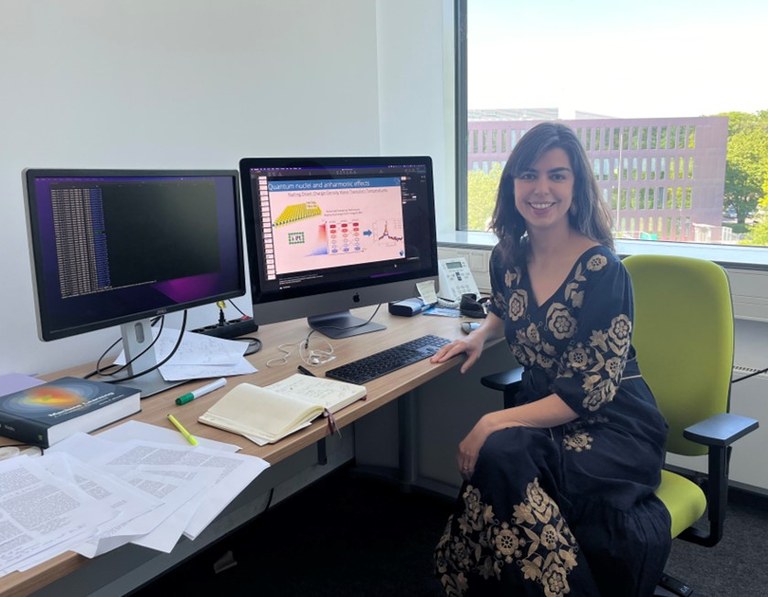
Mariana and her team are currently conducting cutting-edge research on the effects of temperature and quantum nuclear motion on the properties of complex weakly bonded systems. This requires the application of quantum mechanics principles to both electrons and nuclei. To overcome previous limitations in studying high-dimensional realistic systems, Mariana and her team are at the forefront of developing and implementing first-principles quantum mechanical methodologies. These innovative approaches combine density-functional theory and path-integral methods, augmented by machine-learning models, to explore new length and time scales. They also focus on enhancing the calculation of experimentally observable quantities, with a particular focus on accounting for nuclear motion. Mariana and her team are also interested in non-equilibrium phenomena at molecular-solid interfaces and nonadiabatic effects in quantum nuclear motion.
Foto-Rechte: Dr. Mariana Rossi
May
B.Sc. Isabel König (Kiel) - Kalenderwoche 22
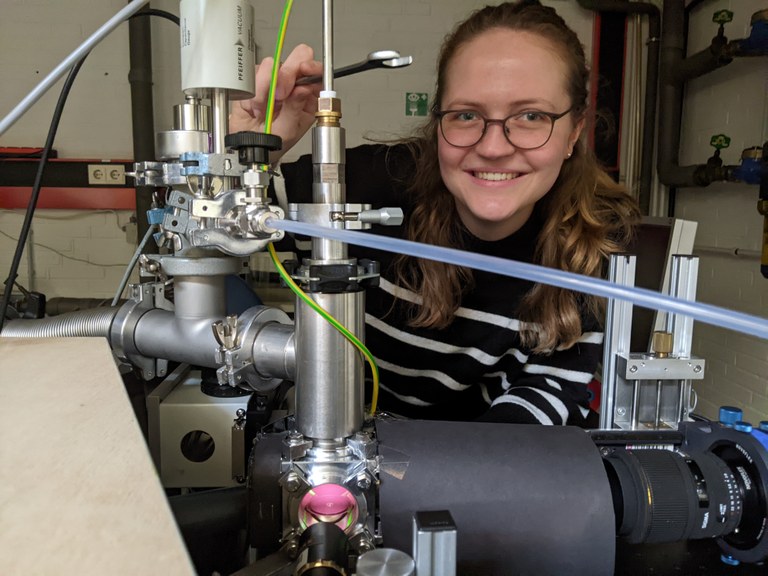
Isabel, a master's student at Kiel University, is working on her thesis in Prof. Dr. Jan Benedikt's Experimental Plasma Physics research group under the supervision of Dr. Franko Greiner. Her focus is the investigation of the charging of non-spherical particles in a dusty plasma. She uses long-distance microscopy and the phase-resolved resonance method to analyze the charging of micrometer-sized particles. Isabel's initial fascination with the physics of dusty plasmas sparked during the 2014 physics project in Kiel. Now, she's part of the organizing team for this year's event, dedicated to the mission of inspiring more young women to explore the wonders of physics and science.
Foto-Rechte: Karin Hansen
Dr. Claudia Merger (Trieste, Italy) - Kalenderwoche 21

Claudia recently joined the Theory of Neural Networks group at the Scuola Internazionale Superiore di Studi Avanzati (SISSA) in Trieste, Italy, as a postdoc after obtaining her PhD degree at RWTH Aachen University and Forschungszentrum Jülich. She works on neural networks, such as modern image and text generators whose success stems from an intrinsic, condensed representation of the statistics of the data used to train them. Conventionally, this representation does not lend itself to a direct interpretation. Claudia decodes these representations by translating them into a physical language, namely interactions between the different degrees of freedom that make up new data, such as pixels, in the case of image generation. In doing so, she obtains an interpretable new interacting theory of the data and can also study if different types of neural networks are biased towards specific representations. Thus, she works at the crossroads between explainable artificial intelligence (AI) and inference - she believes that by explaining what neural networks (the central objects of modern AI) have learned, we can obtain a better understanding of the problems they solve and simultaneously improve their reliability and efficiency.
Foto-Rechte: Dr Claudia Merger
Prof. Dr. Dorothée Weber-Bruls (Frankfurt am Main) - Kalenderwoche 20
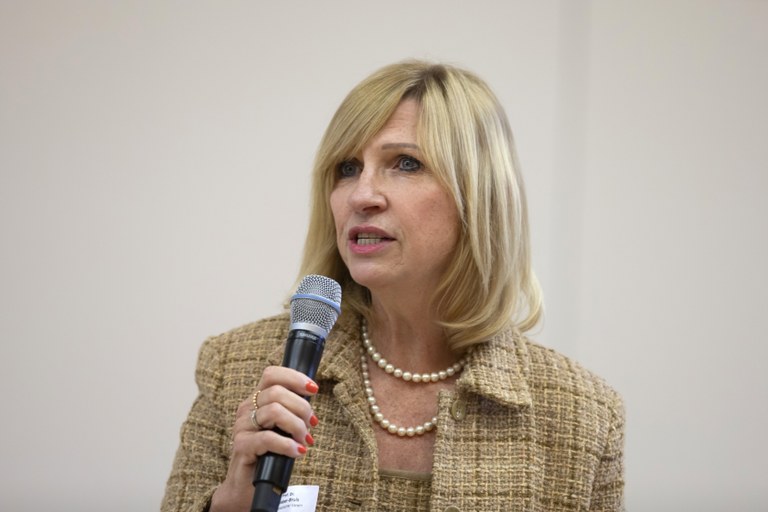
Foto-Rechte: Prof. Dr. Dorothée Weber-Bruls
"Material Girls": Diana Ryzhak, Henriette Tetzner, Agnieszka Corley Wiciak, Elena Hardt, Maria Masood, Costanza Manganelli, and Farnaz Majnoon (Frankfurt (Oder)) - Kalenderwoche 19
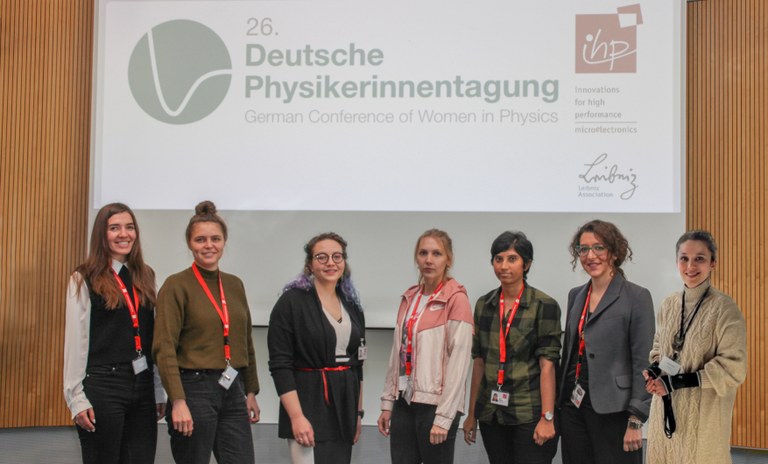
Their focus spans the intricate realms of materials science, delving into photoluminescence, defect investigation in micro- and nanostructures, and the development of cutting-edge semiconductor-based devices. In domains such as optoelectronics, thermoelectrics, biosensors, and quantum applications, these dedicated scholars channel their passion for innovation and advancing technology within their field into collaborative efforts.
What sets these women apart is not just their ambition to revolutionize the size of electronic devices but also their commitment to ushering in a new era of green electronics and redefining the landscape of programming - making it faster, cheaper, and more effective. Beyond technological progress, their collective endeavors offer profound insights into the fundamental physics of materials at the nanoscale.
While the number of women in STEM, especially in electronics and engineering, remains disproportionately low, IHP's Material Girls stand united. They support one another, contributing not only to scientific breakthroughs but also to a more inclusive environment for girls in science and research. Their collaborative spirit exemplifies a commitment to paving the way for a brighter future in this traditionally male-dominated field.
Foto-Rechte: Inesa Posypai
April
Dr. Larissa Boie (Villigen, Switzerland) - Kalenderwoche 18
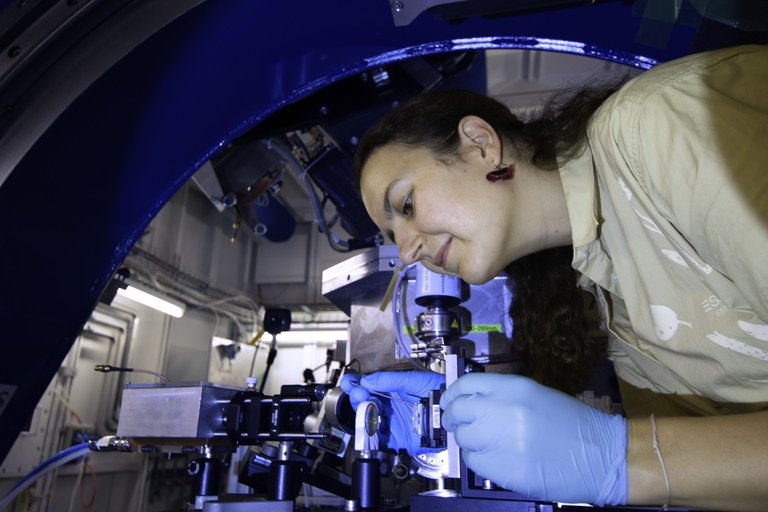
Larissa is an experimental physicist at the Paul Scherrer Institute in Villigen, Switzerland. She currently conducts research in the field of laser-based advanced manufacturing. With very short pulses and small laser spot sizes, they can use IR light to modify a transparent material locally via multi-photon absorption processes. This can lead to new functionalities at the surface of glasses, such as photoconducting properties. With synchrotron radiation from the Swiss Light Source, they investigate how a femtosecond laser transforms parts of a metallic glass into a crystalline phase in operando conditions to understand the role of different laser parameters. She is also planning and conducting ultrafast optical experiments in a laser lab, investigating how fast the lasers change the internal arrangement of the atoms in the glass. The work on advanced manufacturing processes combines her interest in both x-rays at large research facilities and the freedom to work on her own setup in a laser lab, building on her expertise in ultrafast dynamics from her Ph.D. research. With their results, they hope to find mechanisms that allow them to do laser-writing in three dimensions in transparent glasses, which can be useful in building novel types of chips and other miniature devices.
Foto-Rechte: Rasmus Ischebeck
Dr. Laura Olivera-Nieto (Heidelberg) - Kalenderwoche 17
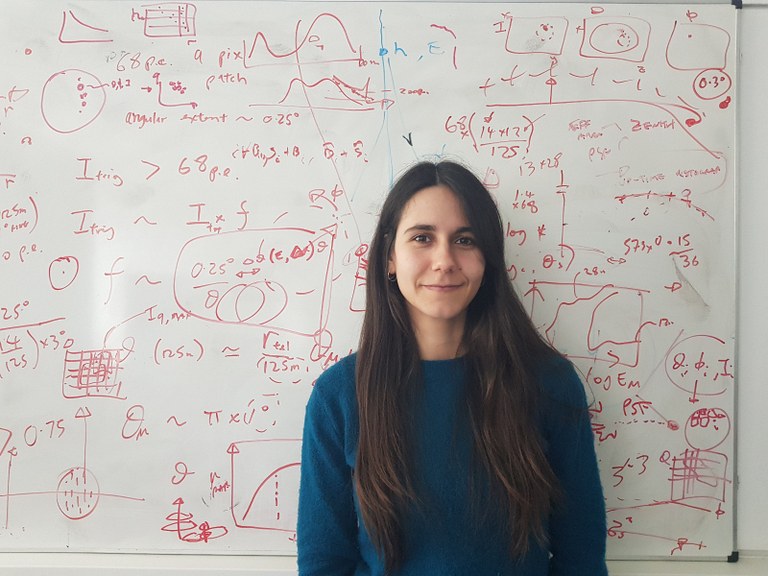
Laura is a postdoc at the Max-Planck-Institut für Kernphysik in Heidelberg after recently completing my Ph.D. at the same institute. She is a gamma-ray astrophysicist, using observations of the sky in the TeV energy band to study the places in the universe that accelerate particles. Her research is currently focused on microquasars, a special type of stellar binary system hosting a black hole pulling off matter from its companion. As a result, oppositely directed beams of plasma ("jets") are produced. Similar relativistic jets are also observed emanating from the centers of active galaxies, although with much larger sizes. Using data taken with the H.E.S.S. observatory, she studies microquasars inside our Galaxy in order to characterize where and through which mechanisms are particles accelerated to energies above hundreds of TeV in these systems.
On the more experimental side, she developed a novel method for background rejection that uses the central telescope as a "muon veto," improving the high energy sensitivity of H.E.S.S., and she contributes to the Southern Wide-field Gamma-ray Observatory (S.W.G.O.), a proposal for a new gamma-ray observatory in the Southern Hemisphere. Additionally, she is one of the lead developers of the Very-High-Energy Open Data Format. This community initiative aims to provide the field of astroparticle physics with a shared, open-source data standard that ensures the FAIR principles and facilitates data-sharing and reproducibility.
Laura received the Wilhelm and Else Heraeus Dissertation Prize 2023 for her PhD thesis on "Resolving particle acceleration and transport in the jets of the microquasar SS 433 with H.E.S.S. and HAWC."
Foto-Rechte: Dr. Laura Olivera-Nieto
Dr. Andrea Toulouse (Stuttgart) - Kalenderwoche 16
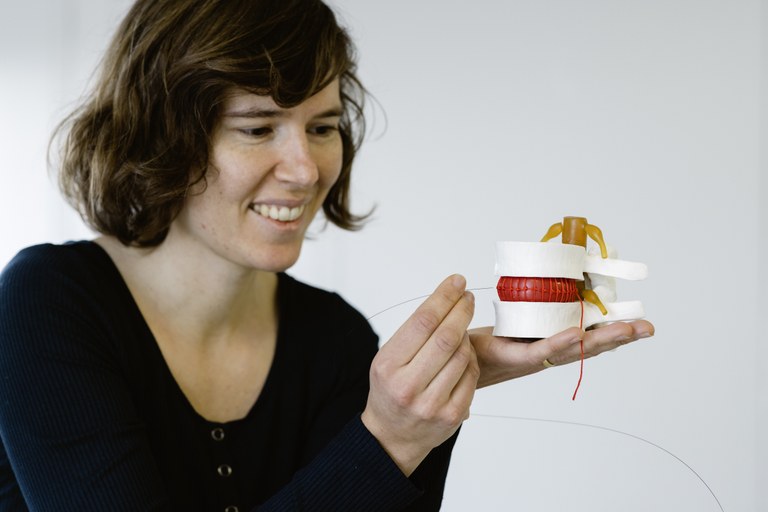
Foto-Rechte: Dr. Andrea Toulouse
M.Sc. Radostina Zidarova (Darmstadt) - Kalenderwoche 15
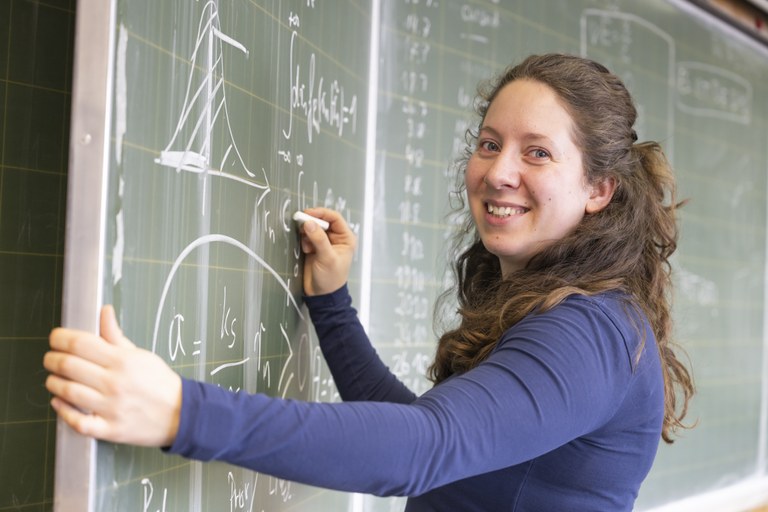
Radostina is a Ph.D. student conducting fundamental research in nuclear physics at TU Darmstadt. She aims to explore the properties of exotic radioactive atomic nuclei, which are produced through impinging accelerated ion beams on a target. After identifying the ions based on their behaviors, gamma-spectroscopy is performed to measure the radiation emitted during proton and neutron decay from the nucleus's excited states. Radostina's current research is focused on unstable Sc and Ti isotopes with a greater number of neutrons than protons, which were produced and analyzed at Japan's RIKEN Nishina Center. Investigating nuclei far from stability provides insight into the strong nuclear interaction and its behavior, which would not be possible by exploring only stable nuclei.
Foto-Rechte: Klaus Mai/ TU Darmstadt
Dr. Angela De Rose (Freiburg im Breisgau) - Kalenderwoche 14
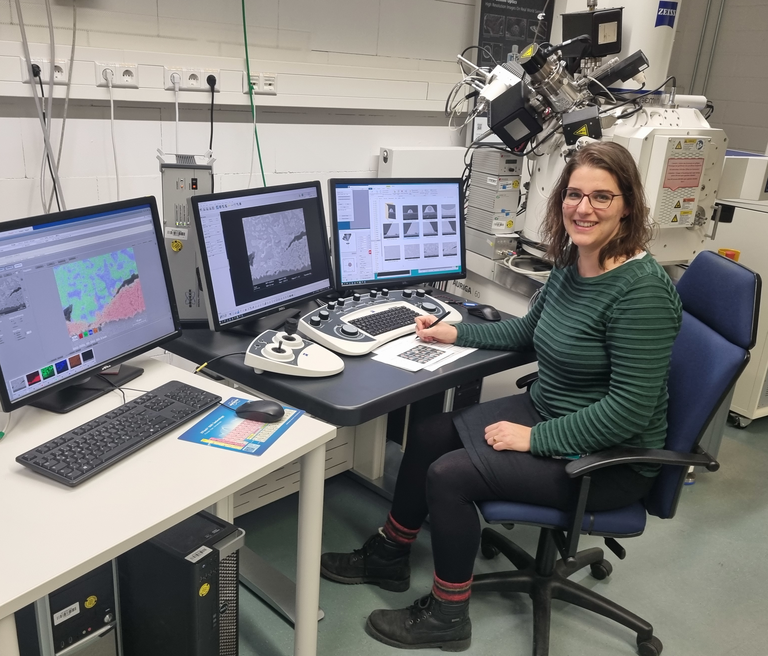
As a woman in science in a male-dominated technical working environment, she tries to get young women interested in research, e.g., through talks at schools or careers fairs, science communication, supervision of PhDs, or hands-on activities, such as GirlsDay.
Foto-Rechte: Angela De Rose
March
Dr. Franziska Treffert (Livermore, CA, USA) - Kalenderwoche 13
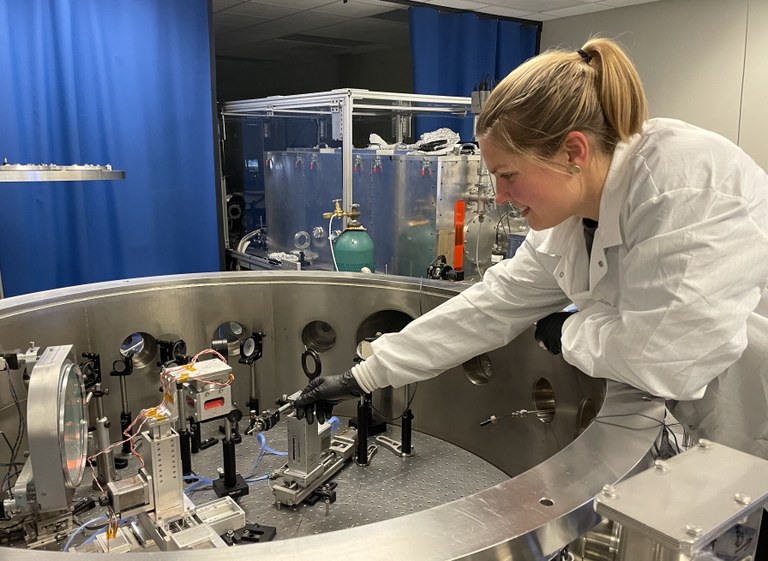
Franziska is an experimental postdoctoral researcher at Lawrence Livermore National Laboratory (LLNL) in California (USA), where she works on High Energy Density (HED) science experiments at the National Ignition Facility (NIF) and other facilities in the US and abroad. Her research focuses on the generation of secondary particle sources (x-rays/ions/neutrons) for material science, fusion science, and medical applications, primarily using high-power, high repetition-rate short-pulse lasers. This includes developing high repetition-rate compatible targetry and detectors as well as leveraging machine-learning models for active feedback loops from diagnostics outputs to laser control inputs to stabilize and optimize particle beam generation. Additionally, she is working on utilizing such particle beams to study HED states of matter, including measuring the equation-of-state of materials under extreme conditions and studying novel approaches for Inertial Fusion Energy (IFE), motivated by recent breakthroughs regarding ignition at the NIF. Her research builds on work from her Ph.D. project, which was conducted in collaboration between TU Darmstadt and SLAC National Accelerator Laboratory (USA), for which she was awarded the German Academic Scholarship Foundation (Studienstiftung des deutschen Volkes) doctoral scholarship.
Foto-Rechte: Prof. Dr. Jorge Rocca
Dr. Aisha Aqeel (Munich) - Kalenderwoche 12
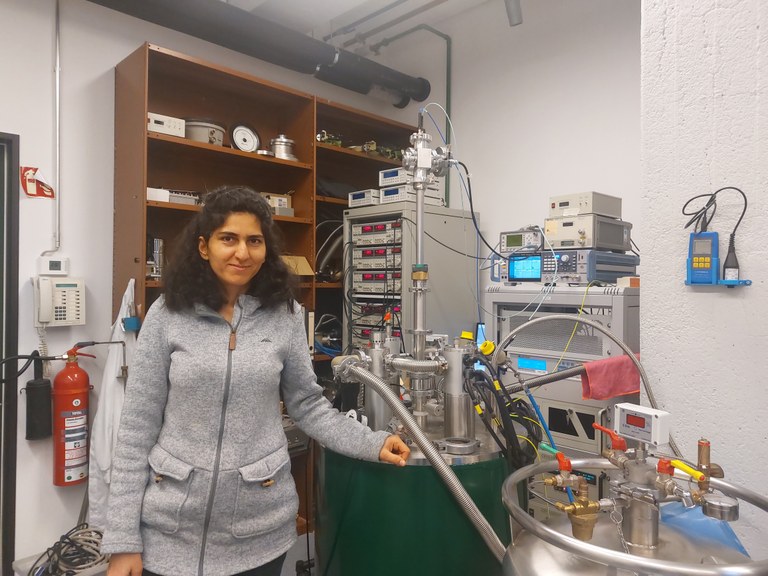
Employing crystal growth techniques, Aisha cultivates magnetic materials and subsequently subjects them to characterization through various methods such as magnetometry, x-ray scattering, and magnetic resonance techniques. These materials are then utilized to comprehend fundamental device concepts by harnessing their spin properties. Aisha finds it particularly intriguing to unravel a material's true potential after its growth.
In her previous work, she focused on single-crystal growth and in-depth analysis of spin transport and magnetic resonance properties in chiral magnetic insulators like Cu2OSeO3. In the context of the SpinLEGO project, her goal is to investigate a varied selection of noncollinear magnetic materials, emphasizing achieving ultralow magnetic damping and establishing strong coupling to microwave photons.
In their recent publication, they present the initial experimental investigation employing these novel magnets for applications in artificial intelligence, particularly reservoir computing.
Foto-Rechte: Dr. Aisha Aqeel
Prof. Dr. Nahid Talebi (Kiel) - Kalenderwoche 11
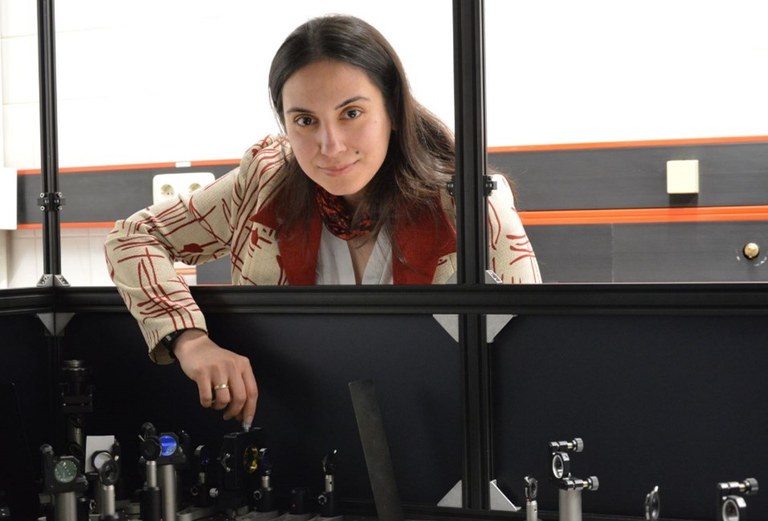
Nahid is an Iranian/German physicist who focuses her research on nanooptics, exploring the intricate dynamics of light-material interactions at the nanoscale. She leads the Nanooptics research group at the Christian-Albrecht University of Kiel. Her work primarily revolves around elucidating the interplay between light and material excitations, with a particular emphasis on probing these phenomena using electron beams.
Her expertise encompasses theoretical and experimental explorations of the interactions between light, electron beams, and matter. She leverages electron microscopes as a toolbox to better explore quantum dynamics, with a focus on sub-femtosecond dynamics and nanometer spatial resolutions.
Central to Nahid's contributions is the development of a numerical Maxwell-Schrödinger toolbox, enabling her to explore dynamic processes beyond adiabatic and nonrecoil approximations. Additionally, she has pioneered a novel method for investigating the decoherence dynamics of material excitations, such as exciton-polaritons and electron-phonon interactions in two-dimensional materials.
In 2018, she was awarded an ERC Starting Grant to further her investigations, followed by an ERC Proof-of-Concept Grant in 2024 to advance her innovative prototypes toward commercialization.
Foto-Rechte: Julia Siekmann
M.Sc. Sahar Forouzan (Deggendorf) - Kalenderwoche 10
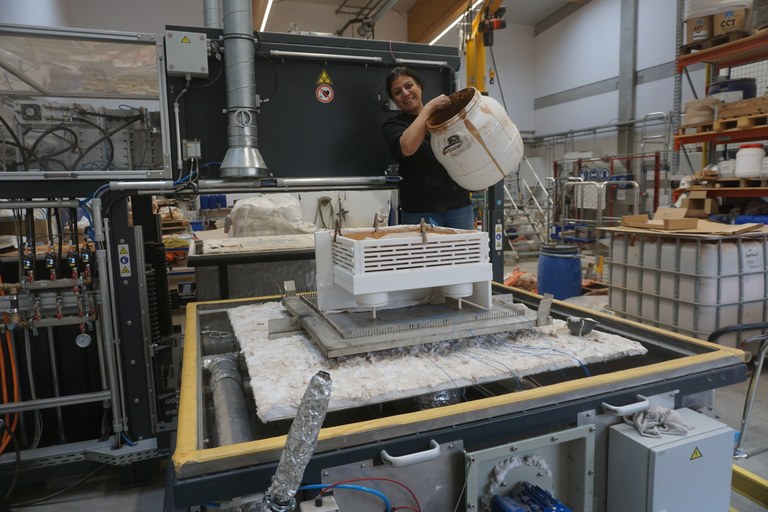
Sahar is a Ph.D. student at the Technische Hochschule Deggendorf and the FAU Erlangen. In her dissertation, she researches the treatment of ceramics using microwave technology. The application of microwaves offers an opportunity to save a substantial amount of energy in the ceramic industry and significantly reduce our reliance on fossil fuels. The aspiration is to manufacture ceramics in an environmentally friendly manner. This project was a collaboration between the Deggendorf Institute of Technology and Schlagman Poroton Company.
Foto-Rechte: M.Sc. Sahar Forouzan
M.Sc. Serena Giardino (Potsdam) - Kalenderwoche 9
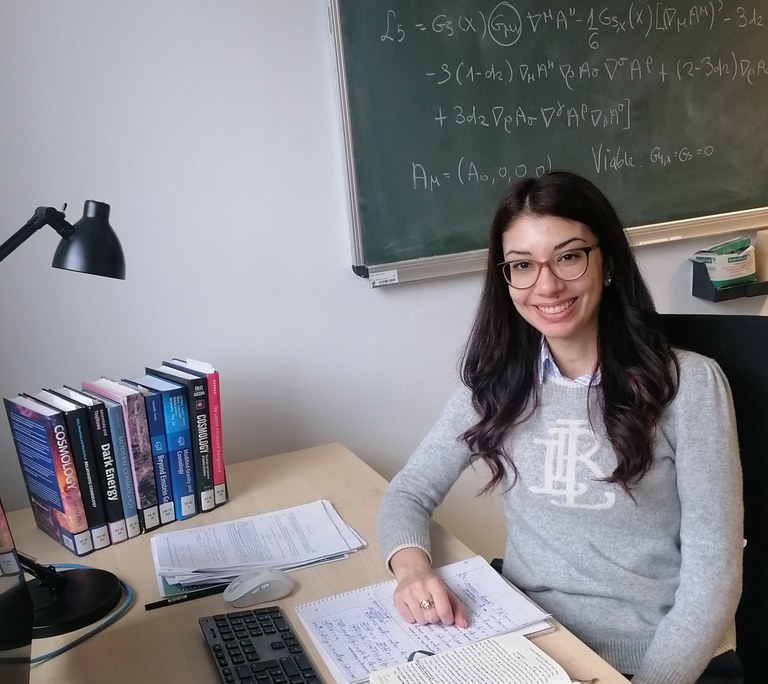
She enjoys bringing science to the public in several languages and is active in her institute's Equal Opportunity Office.
Foto-Rechte: M.Sc. Serena Giardino
M.Sc. Chloé Gaudu (Wuppertal) - Kalenderwoche 8
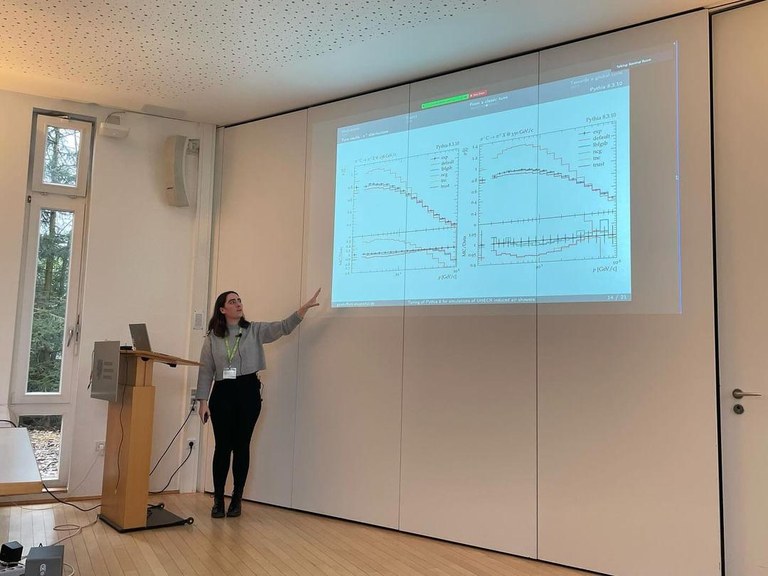
Chloé is a Ph.D. student in the Astroparticle physics group at the University of Wuppertal, working with hadronic interaction models to solve the “Muon Puzzle.”
Established state-of-the-art models, including EPOS-LHC, Sibyll 2.3d, and QGSJet-II.04, are utilized by astroparticle physicists to describe the hadronic interactions within extensive air showers (EAS) resulting from cosmic ray interactions with Earth's atmosphere. Though developed by separate teams with differing initial assumptions, these models converge on the following consensus: air shower simulations exhibit a muon deficit compared to experimental measurements of the Pierre Auger Observatory — referred to as the “Muon Puzzle.” To solve this puzzle, Chloé works with the Angantyr model of Pythia 8, yet another hadronic interaction model tailored for Large Hadron Collider experiments. Angantyr introduced new features aimed at enhancing descriptions of hadron-nucleus interactions, thus motivating its potential application in air shower studies. The evaluation and validation of this model are done using the analysis framework Rivet, which requires specific plug-ins, of which Chloé has written several for each experimental dataset chosen as a reference. The next steps for her work would be to create a tuned version of Pythia 8 by adjusting parameter values, shifting the physics of Pythia to better describe hadron productions in pion-proton and pion-carbon interactions while keeping intact the knowledge they have gathered so far from proton-proton interactions. This tuned Pythia 8 would be used in codes, like Corsika 8 or MCEq, to probe astroparticle observables, allowing comparison with experimental datasets and previous simulations with the aim of a more accurate description of muon production in EAS.
One should keep in mind that this tuning endeavor is a multi-dimensional task demanding various expertise in the fields of astroparticle and particle physics, from the experimental datasets, model parameters, and observable weight selection for meaningful interpretation, needing a close collaboration between working groups.
Foto-Rechte: Pavlo Plotko
Dr. Esra Bulbul (Garching/Munich) - Kalenderwoche 7
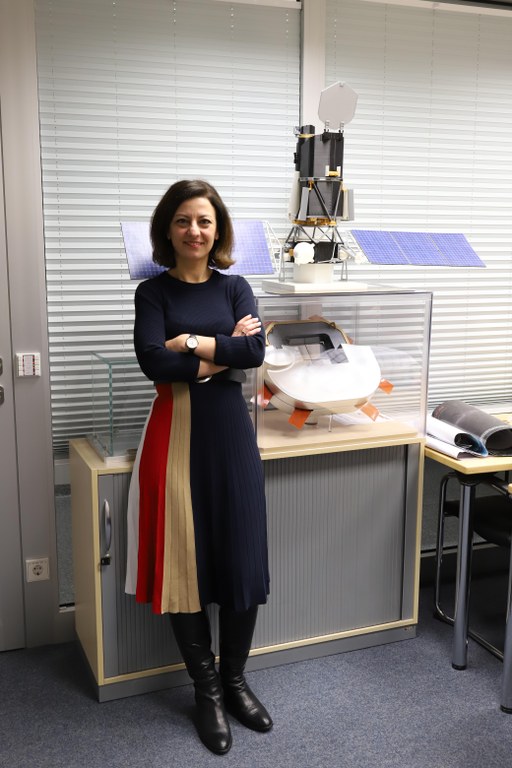
Foto-Rechte: Dr. Esra Bulbul
M.Sc. Verena Johanna Brehm (Trondheim, Norway) - Kalenderwoche 6
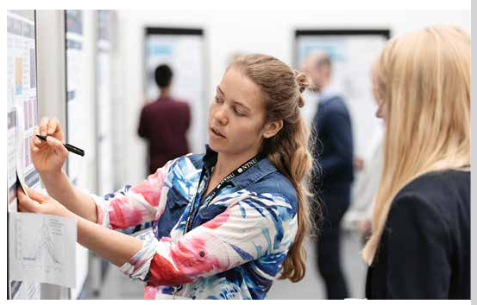
Verena is a Ph.D. student in the Center for Quantum Spintronics, which is part of the Norwegian University of Science and Technology in Trondheim. After studying general physics in the Bachelor and Masters in Konstanz, Germany, she specialized in theoretical solid-state physics. Using large-scale numerical methods, she simulates the behavior of magnetic waves for magnonic devices and neuromorphic spintronics. By using the spin- instead of charge property of electrons as information carriers, novel magnetic devices promise to improve both computational speed and energy efficiency.
Foto-Rechte: M.Sc. Verena Johanna Brehm
Januar
Prof Dr. Francesca Calegari (Hamburg) - Kalenderwoche 5
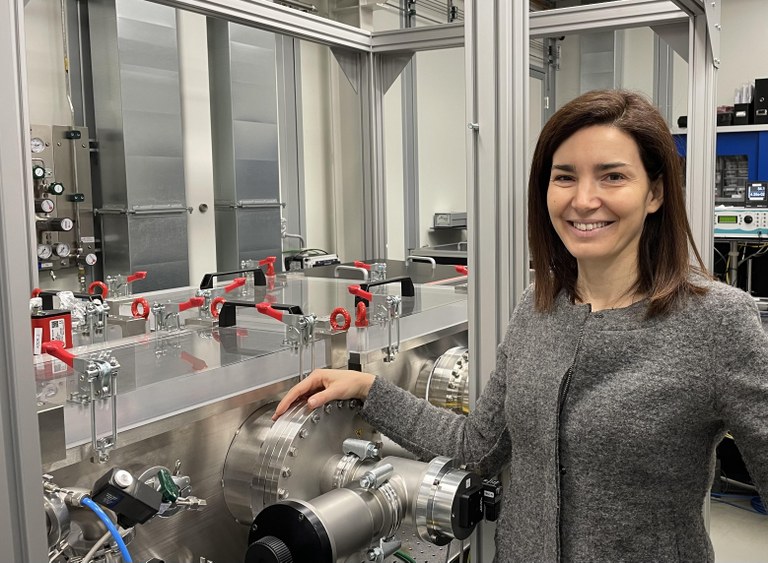
Francesca leads the Attosecond Science group at the Center for Free-Electron Laser Science at DESY in Hamburg and is a full professor of physics at Hamburg University. She is also the head of the scientific board of PIER, the strategic partnership between DESY and Hamburg University, and one of the speakers of the Cluster of Excellence “Advanced Imaging of Matter.” Amongst other distinctions, she is an ERC StG laureate, received the ICO prize and the Ernst Abbe medal from the International Commission of Optics, and is an Optica Fellow.
The main focus of her research is to track and ideally control in real time the electron dynamics occurring in systems with increasing complexity, from simple molecules to molecules of biological interest and nanostructured materials. To this purpose, her group develops state-of-the-art table-top light sources providing extreme time resolution (from a few femtoseconds down to attoseconds) and spanning from the infrared to the ultraviolet and then further down in wavelengths to the soft-x ray spectral range. In her group, attosecond technology is used to understand the role of electron dynamics in the photo-induced chemical changes that occur in our own biomolecules (e.g., DNA and proteins) in a bottom-up approach. Her research aims to control molecules' chemical reactivity at the electron time scale (attochemistry) to achieve efficient light harvesting. Her approach is fully synergetic, with the possibility to resolve structural changes in molecules through femtosecond time-resolved X-ray diffraction using XUV/X-ray Free Electron Lasers (FELs).
Francesca is active in promoting diversity in science. She has been the Equal Opportunity director for the cluster of excellence AIM and is mentoring female scientists via the DynaMENT mentoring program in Hamburg.
The picture shows Francesca in her Attosecond Science Lab.
Foto-Rechte: Prof Dr. Francesca Calegari
Dr. Felicitas Mokler (Heidelberg) - Kalenderwoche 4
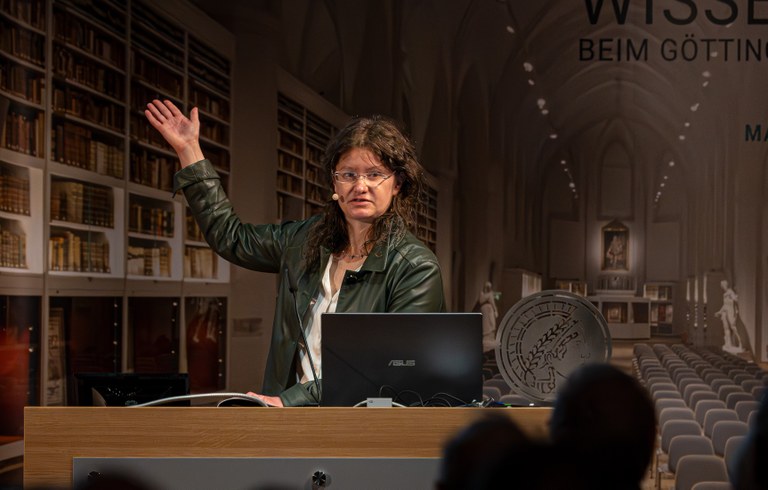
During the scientific year „Our Universe“ in 2023, she worked as science coordinator for the Roadshow „Universe on Tour“ on behalf of the Council of German Observatories (Rat Deutscher Sternwarten) at MPI for Radioastronomy.
Felicitas has been awarded the Klartext-Preis 2008 (award on public writing) for an essay about her thesis topic. In September 2023, she received the Hanno and Ruth Roelin Award for Science Journalism. Later, in 2024, she will take on the position of Journalist in Residence at HITS (Heidelberg Institute for Theoretical Physics).
The photo shows her during her presentation at the Göttinger Literaturherbst, where she presented her book „Die Evolution des Universums“ („The Evolution of the Universe“).
Foto-Rechte: MPINAT
M.Sc. Alba Gómez-Segalàs (Vienna) - Kalenderwoche 3
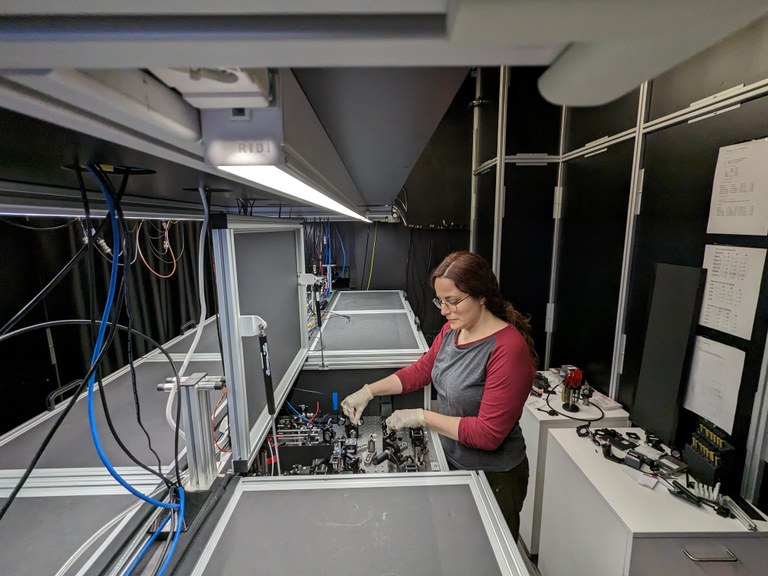
Alba is a Ph.D. student in the research group of Dr. Francisco Balzarotti at the Research Institute of Molecular Pathology in Vienna, Austria. Her academic journey has taken her across borders, with a bachelor's degree in physics from "Universitat de Barcelona" (Barcelona, Spain) and a master's degree in optics and photonics from "Karlsruher Institut für Technologie" (Karlsruhe, Germany). She is captivated by fluorescence light microscopy and its application in the life sciences, and her research focuses on MINFLUX, a single-molecule localization approach that achieves isotropic nanometer localization precision and a temporal resolution down to the sub-millisecond range. She works on expanding the functionalities of a MINFLUX microscope to enable the simultaneous tracking of multiple fluorescent targets, a capability that holds great promise for unraveling intricate molecular dynamics like the conformational states of protein complexes.
They recently posted a preprint showing their latest technological advancements that made possible the first demonstration of two-emitter MINFLUX tracking in 3D.
Foto-Rechte: M.Sc. Alba Gómez-Segalàs
Dr. Stefanie Todt (Dresden) - Kalenderwoche 2
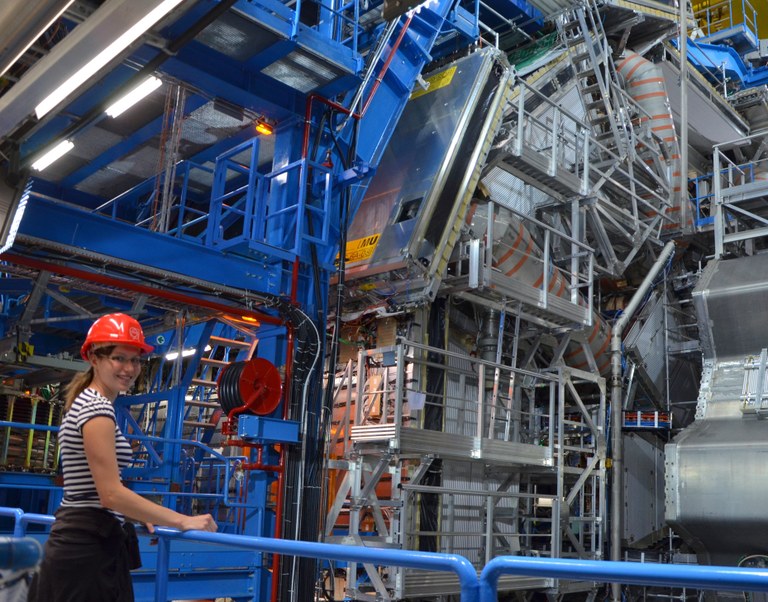
Stefanie is a particle physicist at the Dresden University of Technology (TUD) and part of the ATLAS experiment at the LHC at CERN.
Her research focuses on scattering processes among electroweak gauge bosons. Including triple and quartic electroweak self-coupling interactions as well as the exchange of a Higgs boson, these scattering processes are an excellent tool for studying the delicate interplay of the gauge structure and the electroweak symmetry-breaking mechanism of the Standard Model (SM).
Her research projects examine the scattering of two same-charge W± bosons and contributed to the first observation of a process containing vector boson scattering with data from the ATLAS experiment at the LHC.
Furthermore, she studies the effects of an effective field theory (EFT) model describing beyond SM extensions that generate anomalous quartic gauge couplings in the electroweak sector.
For over 10 years, she has been active in outreach, mentoring, and supervision. As a mediator for particle physics, she participates in national and international masterclasses for high school students organized by the Netzwerk Teilchenwelt. She likes presenting and discussing her research field in public, at events such as Science in Pubs or the 35c3.
Standing for a supportive and appreciative scientific community, she has been the spokesperson for the German Ph.D. and young scientists representatives in the ATLAS experiment.
Foto-Rechte: Dr. Stefanie Todt
Dr. Christin David (Jena) - Kalenderwoche 1
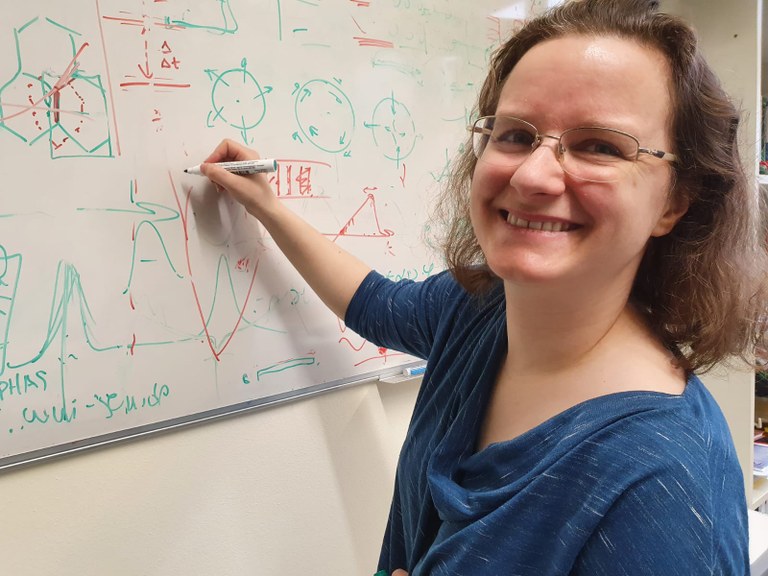
Foto-Rechte: Dr. Christin David
Hier geht es zu den Teilnehmerinnen der Physikerin der Woche 2018, 2019, 2020, 2021, 2022 und 2023 Projekte.